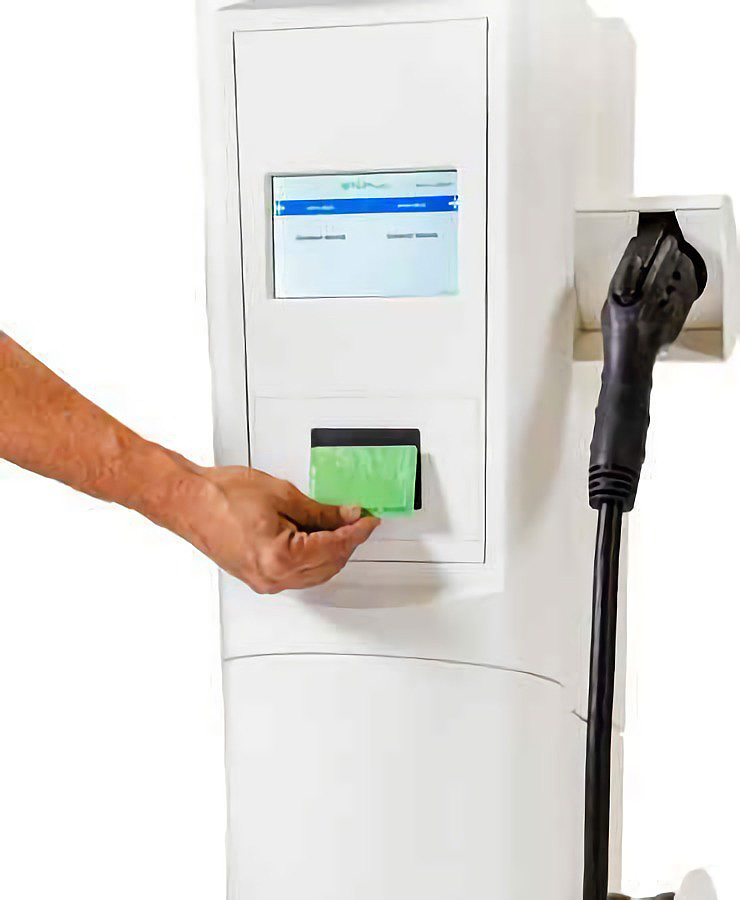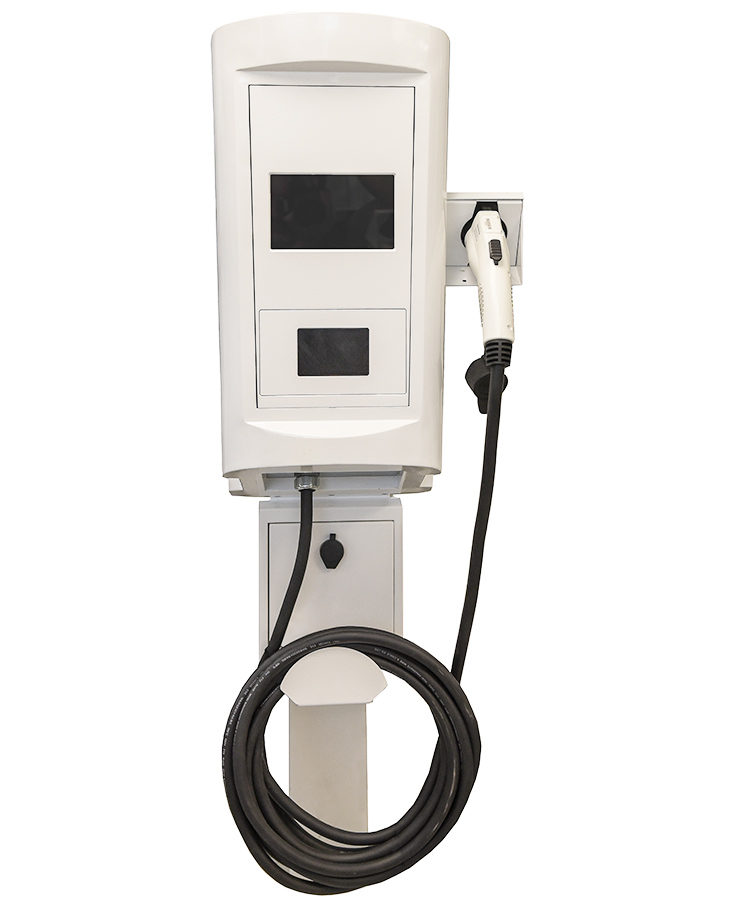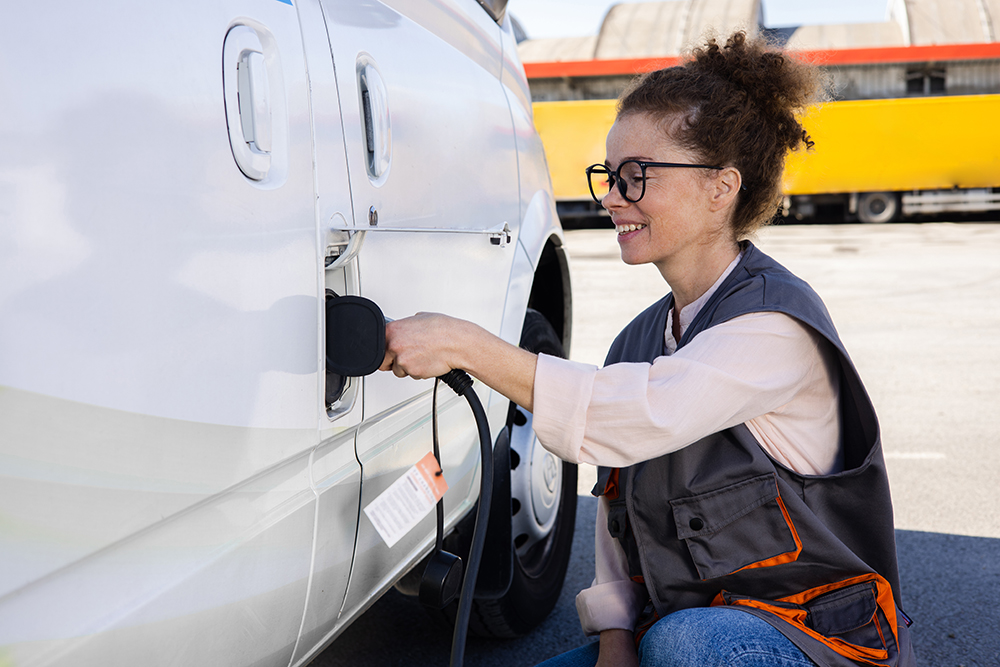
Many fleet owners are looking to electric vehicles (EVs) for the future of their operations, as they can effectively meet daily driving requirements and cover desired distances while providing greater sustainability. While the benefits are numerous, several questions remain for fleet managers to answer.
The fleet environment encompasses special considerations that differ from those faced by individual consumers transitioning to EVs. Fleet managers must consider all of the implications of charging multiple vehicles while ensuring uninterrupted business operations.
And there are several available choices among vehicles and fueling options, which can create a confusing landscape. We provide the answers to questions we commonly hear from fleet owners to help sort through various options as you guide your business to a successful electric future.
What is the difference between a hybrid vehicle and an electric vehicle?
Both types of vehicles, a hybrid model and a fully electric vehicle, contain a battery. The main difference is that a hybrid contains both a combustion engine and a battery and will switch automatically to gas power when its battery is depleted. An all-electric vehicle runs on battery power alone.
Are hybrids or EVs better for fleets?
The answer depends on the type of vehicles a fleet requires and their intended purpose. Fleet owners that require larger or mid-sized trucks, for example, will not find many hybrid trucks or buses available, and when making the switch to a more sustainable fleet, they might need to restrict their search to electric models.
Fleet owners or operators will find a larger variety of models for smaller to mid-sized vehicles. There are all electric or battery-operated vehicles (BEVs), plug-in hybrid electric vehicles (PHEVs) or hybrid electric vehicles (HEVs).
- A plug-in hybrid is an EV with a range extender. Equipped with a small combustion or gas-powered engine, this engine will charge the battery or power the electric motor to supply extra range, with the number of miles varying depending on the size of this engine. The battery for the first two types of vehicles is filled by plugging it into a power source.
- A hybrid has both a battery and an internal combustion engine which runs on gasoline, but the battery is charged by the vehicle’s action, not by plugging it in.
Overall, there are currently more than 30 models of PHEVs or plug-in hybrid electric vehicles available domestically. Among electric light duty vehicles, there are close to 100 models available within the United States and hundreds more internationally.
Many fleet owners that operate locally or within a specific region of the country find that electric vehicles can suit their requirements. As the national infrastructure develops to support a greater number of public charging stations for EVs of all types, cross country trips will become more feasible.
How much does it cost to install an EV charging station for fleet vehicles?
Fleet owners have many choices when it comes to charging equipment to refuel vehicles. The choice of an individual EV charging station will depend on multiple factors. For example, do employees charge at home or is there a dedicated lot?
In the case of a wall-mounted Level 2 EV charger for an individual employee, fleet owners should talk to the fleet sales representative at an EV charging station manufacturer and discuss their needs, usage patterns, the size of the fleet and any anticipated growth, to help determine which style charger will supply the best service for the long term.
Installing a charging station with a DC Fast Charger and supporting tower ranges depending on location, available power, regulations, building codes and the amount of trenching and wiring required.
What if a driver gets stuck without electricity?
There isn’t a fleet owner today that doesn’t incorporate logistics into route planning or fleet management. Proper planning should develop routes that have drivers finishing the day with a 20% charge remaining in the vehicle.
There are other types of fleets however, where routes are unpredictable, or the amount of driving distance and time can vary considerably, such as sales representatives, for example.
Today’s technology offers numerous solutions to help ensure drivers do not completely run out of charge. One of the best tools a driver can carry is a smart phone, with apps that identify charging stations and locations. Even Google Maps offers the option to search for “EV charging stations near me.”
Some apps not only calculate the cost of the charge, but also can predict the distance or range available to the vehicle on that charge. An EV charge card can facilitate payment and cost tracking.

Can fleet operators track electricity?
There are specific software programs and packages for fleet owners. Some are issued by the original equipment manufacturers for the EVs and can track the performance data of individual vehicles within the fleet.
Analytics software can help track fleet vehicles, charging occasions and costs. Using this data, the programs can help increase the ROI for EVs within the fleet and also help companies achieve sustainability goals.
What government incentives and grants are available for adopting fleet EVs?
Various governmental bodies, utilities and organizations offer rebates and incentives to promote the adoption of electric vehicles and to expand the charging infrastructure. These incentives can reduce upfront costs for installing EV charging stations, to make them more financially feasible.
Rebates provide monetary reimbursement or discounts, while grants, tax credits and deductions further offset installation expenses.
These initiatives aim to spur the growth of charging infrastructure, enhance accessibility and facilitate the transition to cleaner transportation.
The U.S. Department of Energy Alternative Fuels Data Center has a searchable database of federal and state laws and incentives, found here.
In addition, the Clean Cities Coalition Network discusses partnerships, projects and funding opportunities.
What if employees keep vehicles overnight?
Truck fleets used for delivery services or forklifts in warehouses for example, can charge in an enclosed lot or dedicated EV charging station within the facility, either overnight or on an alternating shift schedule. However, employees at other types of businesses, such as members of a national or regional sales force, might take the EV home at night, with the responsibility to charge and maintain it on their own.
Employers have different options for a charging solution in the case of employees who park a vehicle at home. Fleet owners can install a home charging station, with features like an access card or code that limits usage to authorized individuals.
Companies should establish clear charging agreements or policies with employees to set expectations and guidelines for EV charging. In addition, there are software solutions available that can track both mileage and the amount of charging required for electric vehicles.
These software platforms provide fleet management capabilities specifically designed for EVs. These can monitor and record the mileage for each EV in the fleet; track charging sessions including energy consumption and charging location. Some of these software programs for EV fleet management include Fleet Carma, Geotab, and Greenlots, to facilitate efficient monitoring of mileage and charging activities. An EV charger manufacturer can help in finding the right mix of EV charging stations.
What type of chargers or charging stations should I install for fleet service?
Fleet owners with a dedicated lot have a choice between Level 2 and Level 3 DC fast chargers, depending on their specific needs and purposes. For an explanation between different types of chargers, read our blog, AC & DC EV chargers.
The size of the vehicles at the lot and the battery capacity can vary and help determine the best choice for an EV charging station. The battery pack in a smaller vehicle may be 50-100 kW, while that of a class six truck might be 300-400 kW.
The predictable patterns for parking time, combined with the battery capacity, help determine the charger selection.
- Level 2 chargers are suitable for overnight charging or longer stationary periods as they provide a moderate charging speed. These Level 2 chargers are ideal for fleets comprised of small to mid-sized vehicles with predictable and extended periods of downtime, and a smaller battery capacity.
- DC fast chargers offer significantly faster charging speeds, providing up to 80% charge in as little as 10-15 minutes for these types of vehicles. A DC fast charger also can handle the capacity of a larger vehicle, such as the class six truck. These larger vehicles will need fast chargers to reach capacity in the same time as smaller vehicles.
DC fast chargers are recommended when a quick turnaround time is essential for fleet vehicles that need to return to the road quickly. In addition, the DC fast chargers should always accompany or back up a fleet lot equipped with Level 2 chargers, in a ratio of approximately one DC charging port for every ten Level 2 chargers installed.
This backup can supply a fast charge for any vehicle on the lot, or a quick charge if an unscheduled disruption might delay a vehicle’s return to the fleet hub.
Read more about the options and decisions when selecting charging stations for fleet locations in this blog post.
What are the options in fuel cards for EV fleets?
There might be a fuel card offer from the vehicle manufacturer, or fuel card use can be integrated with a software package. Fuel cards from the OEM might be part of a partnership agreement between the OEMs and the charging networks and can work with the software to integrate with the fuel card. And many EV charger manufactures include RFID readers in their retail models that work through an integrator with software to make sure card, apps and various payment options work.
What if our vehicles do a lot of long-haul driving?
Currently, nationwide trucking companies have difficulty finding enough electric fleet vehicles available for purchase to replace trucks being cycled out of service during any given year. Generally, these trucks remain in service for more localized or regional deliveries. As the nationwide EV charging station infrastructure gets built out, the size of electronic fleets will continue to grow.
However, a DC fast charger is capable of charging a class six truck and can be installed within the fleet lot for overnight charging for vehicles traveling long distances. Routes can also be planned along DC fast charger locations.

How long does it take to charge an electric vehicle, and how does it impact fleet operations?
EVs offer a great deal of flexibility in terms of charging options. These can be fueled at fleet facilities, allowing for overnight and idle-time charging, to optimize downtime and make fleet vehicles available during business hours.
Additionally, as the presence builds for public direct-current fast-charging (DCFC) stations along major transportation corridors, the range of EVs options on the road for charging during service extends.
Depending on the range of vehicles in the fleet or distance from service to the fleet location, fleet lots can be outfitted with Level 2 and DC fast chargers, for both overnight and quick charging options to get fleet vehicles back in operation. A DC fast charger can complete a charge in as little as 10-15 minutes, depending on the vehicle’s battery capacity.
How does the total cost of ownership (TCO) of an electric vehicle compare to a traditional vehicle?
The total cost of ownership for an electric vehicle can be offset by potential incentives that lower their initial purchase price. In addition, an EV offers lower costs overall in terms of:
- Higher fuel economy for lower daily operating costs
- Average operation and maintenance costs of approximately three cents per mile for light-duty, all-electric vehicles
- Electric rates are more predictable than gasoline or diesel, to allow for easier long-term fuel predictions and budgeting. Furthermore, lower, off-peak electric rates can further reduce EV fuel expenses.
- Compared to conventional combustion engine vehicles, EVs generally require less maintenance and have a simplified drive train and fewer moving parts that might require replacement.
The intrinsic value of EV fleet ROI is a smart consideration, as EVs assist businesses and organizations in achieving various objectives. Another consideration is that companies can reach environmental goals to build their brand or improve their public image.
Highly visible fleets such as transit lines, school buses, municipal vehicles or police cars and even taxis can demonstrate community leadership by incorporating EVs into their operations.
Moreover, EVs contribute to public fleet compliance with regulations like the Energy Policy Act (EPAct) or state and local transportation policies.
Are there specialized fleet management tools and software for electric vehicles?
These software platforms provide fleet management capabilities specifically designed for EVs. A specialized software package can monitor and record the mileage for each EV in the fleet; track charging sessions including energy consumption and charging location.
Some of these software programs for EV fleet management include Geotab, Samsara, and Greenlots, to name a few, to facilitate efficient monitoring of mileage and charging activities.

What are the best practices for training drivers and employees in using electric vehicles?
Very little training is required, but fleet owners can conduct driver training for proper charging. OEMs often build features into the vehicles to ensure vehicles are plugged in properly to the chargers, and gauges that indicate when a full charge is achieved.
In terms of maintenance, the main component requiring attention will be the tires. Tire life will depend on the type of tire purchased and the type of roads the vehicle encounters.
In terms of training or maintenance, EVs have fewer moving parts so less maintenance, but having maintenance staff attend EV service training is an option.
Software packages can help monitor whether fleet vehicles are properly plugged into the charger and identify early on if there is an issue with either the vehicle or charger.
How can we maintain the charging stations installed in our fleet hub?
First, charging stations require proper installation and servicing to begin operations. Fleet owners typically have many questions regarding their installation, and it helps to have access to the OEM for the charging stations to ensure smooth installation. A review of EV charging station manufacturers and the service plans and maintenance training they offer is a good start.
From forklifts to city buses, BTC POWER has consulted with fleet operations around the country to ensure the vehicles being purchased are compatible with the charging equipment. Companies appreciate the access to engineering and technical support and the customer service BTC POWER offers.
We can offer recommendations for site design to optimize fleet charging and maximize space utilization. Our technicians will travel to your site to commission the charging stations after installation. Customer support representatives also are available to talk through the process.
Preventive maintenance is recommended for the chargers according to a five-year plan. BTC POWER will train your company’s technicians on proper maintenance, upkeep and troubleshooting.

I’m considering different vehicle models for a fleet purchase. How can I ensure vehicles purchased will be compatible with the EV chargers?
BTC POWER places great emphasis on comprehensive testing when fleet owners are considering a vehicle purchase and seek assurance regarding compatibility with the charging equipment. We offer two options in this instance:
- Test at our facilities — We provide a dedicated testing center where companies can conveniently send their trucks or other EVs to the BTC site. This allows customers to verify compatibility with the chargers before committing to a large volume purchase.
- Send engineers to your facility — We can deploy a team of engineers to your location where the model vehicle is under consideration to test compatibility or make modifications to ensure seamless integration with the charging system.
We support our own hardware through our dedicated service group. This is one of the many benefits of dealing directly with the EV charging station manufacturer for the charging hardware.
Looking for more help in finding the right EV charging stations for your fleet? Contact BTC Power to talk to one of our sales engineers who can answer your questions and help find the right mix of L2 and DC fast chargers for your fleet.

